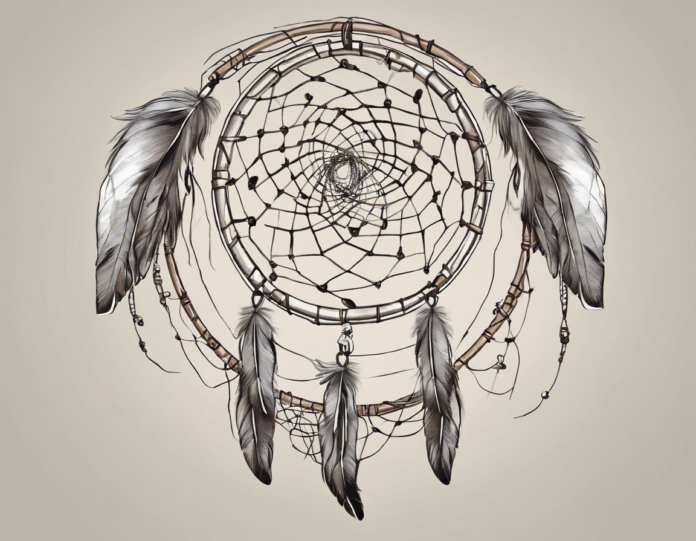Introduction
Dream catchers are a significant symbol deeply rooted in Native American culture, spreading to various parts of the world and gaining popularity for their aesthetic appeal and supposed spiritual benefits. These intricate, handmade objects have become a common fixture in many homes, often displayed for their purported ability to filter out bad dreams and promote positive energy. In this article, we aim to delve into the fascinating world of dream catchers, exploring their origins, cultural significance, construction, and potential meanings.
Origins of Dream Catchers
The origin of dream catchers can be traced back to Ojibwe (Chippewa) Nation, a Native American tribe located in what is now present-day Canada and the United States. The Ojibwe people crafted dream catchers using a circular frame made of flexible willow branches or vines, often decorating them with various materials such as feathers, beads, and semi-precious stones. The web-like pattern within the frame was believed to trap negative dreams, ensuring that only positive dreams could pass through to the dreamer.
Cultural Significance
Dream catchers hold significant cultural importance for many Native American tribes, symbolizing protection and guidance. According to Ojibwe legend, a spiritual being known as Asibikaashi (Spider Woman) would weave her web above the cradleboards of infants to shield them from nightmares. As the Ojibwe people expanded and migrated, they brought this tradition with them, spreading the practice of hanging dream catchers above sleeping areas to promote restful sleep and ward off evil spirits.
Construction of Dream Catchers
Traditionally, dream catchers are constructed using a circular frame symbolizing the circle of life and the interconnectedness of all beings. The frame is adorned with a woven web, typically made of sinew or thread, forming a series of intricate patterns reminiscent of a spider's web. Feathers and beads are often attached to the bottom of the dream catcher, representing elements of nature and adding to its aesthetic appeal.
Meaning of Dream Catchers
The interpretation of dream catchers can vary depending on cultural beliefs and personal perspectives. For some, they serve as talismans of protection, acting as a shield against negative energy and nightmares. Others view dream catchers as symbols of unity and harmony, reminding them of the interconnectedness of all living things. In a broader sense, dream catchers can be seen as reminders to pursue one's dreams and aspirations, filtering out distractions and obstacles along the way.
Are Dream Catchers Only Meant for Good Dreams?
While dream catchers are often associated with filtering out bad dreams and promoting positive ones, their significance goes beyond just dream interpretation. In Native American culture, dream catchers are believed to encompass a broader spiritual aspect, serving as protectors against negative forces and guiding individuals towards their true paths.
Can Anyone Hang a Dream Catcher?
Anyone can hang a dream catcher in their living space, regardless of their cultural background. Dream catchers have transcended their original Native American roots to become a popular decorative item appreciated for their intricate design and symbolism. Whether you are drawn to the aesthetic appeal of dream catchers or resonate with their spiritual significance, they can be a meaningful addition to your home décor.
Do Dream Catchers Need to Be Handmade?
While traditional dream catchers are handmade using natural materials like willow branches and feathers, modern versions are often mass-produced using a variety of materials. Whether handmade or store-bought, the essence of a dream catcher lies in its symbolism and intention. If you value craftsmanship and authenticity, opting for a handmade dream catcher can enhance its spiritual significance and cultural connection.
Do Dream Catchers Have Healing Powers?
Dream catchers are not meant to provide physical healing but are believed to promote emotional well-being and spiritual harmony. By hanging a dream catcher in your sleeping area, you may experience a sense of peace and tranquility, leading to better sleep quality and a more restful state of mind. The healing power of dream catchers lies in their ability to create a soothing environment conducive to relaxation and positive energy.
How Can I Choose the Right Dream Catcher?
When selecting a dream catcher, consider factors such as size, design, and materials used. Choose a size that fits the space where you intend to hang it, ensuring that the design resonates with your personal taste and aesthetic preferences. Pay attention to the colors and symbols incorporated into the dream catcher, as they can carry specific meanings and energies that align with your intentions.
Do Dream Catchers Work for Everyone?
The effectiveness of dream catchers is subjective and may vary from person to person. Some individuals report feeling a sense of calm and relaxation after hanging a dream catcher in their bedroom, while others may not experience any noticeable effects. Ultimately, the power of a dream catcher lies in the symbolism and intention behind it, so it is essential to approach it with an open mind and positive energy.
Conclusion
Dream catchers continue to captivate individuals worldwide, serving as symbols of protection, unity, and spiritual guidance. Whether you are drawn to their cultural significance or simply appreciate their intricate beauty, dream catchers hold a timeless allure that transcends cultural boundaries. By understanding the origins, construction, and meanings of dream catchers, we gain a deeper appreciation for these enchanting objects that have woven themselves into the tapestry of human history and imagination.

